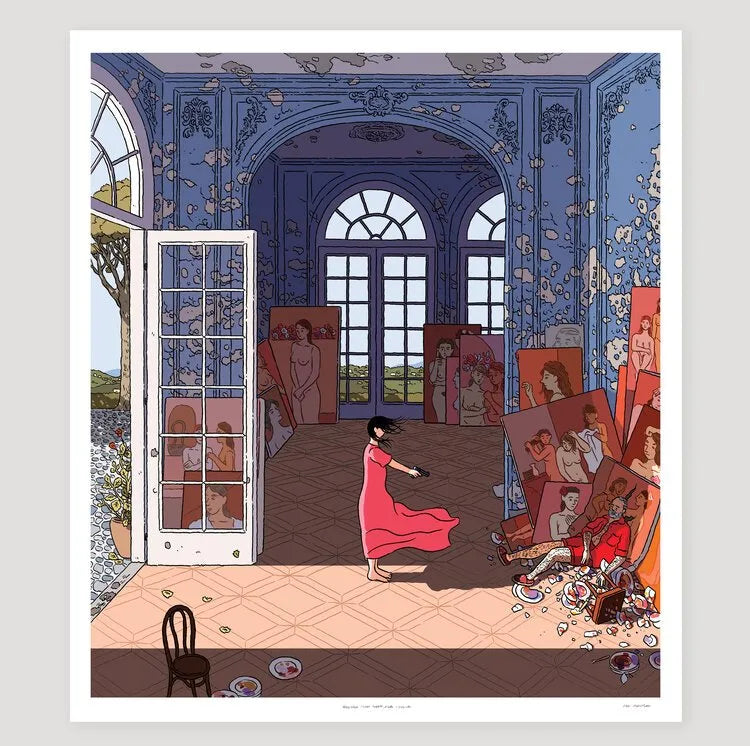Ilya Milstein’s The Muse’s Revenge is a striking artwork. The central female figure moves with a sense of confidence and power, perhaps throwing open the large windowed doors to face the man who has profited off of her body. The room is filled with large canvases of nude women in different poses; the artist himself lies broken among his art and paints. The work invites viewers to consider the many male artists who have used women’s bodies as stepping stones to their fame. Included in this list of male artists are Pablo Picasso, Paul Gauguin, and Edward Hopper.
Pablo Picasso
Six women are credited with markedly influencing Pablo Picasso’s works: Fernande Olivier, Olga Khokhlova, Marie-Theresa Walter, Dora Maar, Francoise Gilot, and Jacqueline Roque. Each of these women sacrificed for and/or inspired Picasso’s works. Fernande Olivier admitted to Picasso locking her up when he would leave. He refused to allow Olga Khokhlova to divorce him when their marriage ended. Marie-Theresa Walter was just 17 when her relationship with Picasso started, who was 45 at the time. Dora Maar was the impetus behind Picasso's great work Guernica. He kept many of his mistresses from pursuing their own careers/passions and had a habit of leaving women if they became ill. Picasso’s granddaughter, Marina Picasso, described his relationships saying, “He submitted them to his animal sexuality, tamed them, bewitched them, ingested them, and crushed them onto his canvas. After he had spent many nights extracting their essence, once they were bled dry, he would dispose of them.” This sentiment is mirrored by Picasso himself who is quoted saying “Each time I leave a woman, I should burn her. Destroy the woman, destroy the past she represents.” Picasso’s works are overwhelmingly depictions of women yet he treated women with disdain and abuse. His misogynistic ideology held that women were either doormats or goddesses.

Paul Gauguin
Paul Gauguin is a well-known post-Impressionist artist whose experimental nature made him a leading figure in the symbolist art movement. Many of his most renowned and popular works come from his time spent among the people in Tahiti. While there were surely many men who inhabited the island, this would not be apparent from looking at Gauguin’s works, which almost exclusively depict the Tahitian women. From Tahitian Women on the Beach to the Spirit of the Dead Watching, Gauguin’s canvases are filled with women and girls. Gauguin went to Tahiti, abandoning his wife and children, with colonialist ideas in mind about the ‘exotic’ and ‘erotic’ lifestyle of the Tahitian people. Once there, he found his first muse and ‘native’ wife, Teha’amana, who was 13 while Gauguin was 43. Their marriage lasted a few years during which time Teha’amana conceived and bore a child. Years later when Gauguin came back to the island, she refused his offer to live with him again. She was not the only child Gauguin is reported to have intimate relationships with. It is believed that he gave syphilis to many adolescent girls as well as three children while he was in Tahiti. Gauguin took advantage of these girls and the Tahitian women. He used and sexually abused them while taking their images and using them to carve out his place as a world-renowned artist.

Edward Hopper
Edward Hopper is a celebrated realist painter whose oil paintings are known for their sense of melancholy and/or isolation. His work Nighthawks has been recognized as one of the most famous works of the 20th century in America. While he and his works are remembered and honored, his wife Josephine Nivison-Hopper is often forgotten. Nivison-Hopper was an artist herself and played a monumental role in Hopper’s success. She was the better-known artist at the beginning of their relationship. Nivison-Hopper received an invite to show at the Brooklyn Museum alongside Georgia O’Keeffe and John Singer Sargent. Hopper wasn’t having much luck and hadn’t sold a painting in over a decade, and Nivison-Hopper wanted to help so she asked the Brooklyn Museum if they wouldn’t mind putting Hopper's works on display along with hers. They said yes and from there Hopper’s career took off. He disliked having two artists in the family, so he often belittled Nivison-Hopper’s works and told her that no one liked them. He considered her painting to be a fun little hobby for her and referred to her works as “little bastards.” Hopper went as far as to reject his own wife’s submissions when he sat as a juror for group exhibitions. She became a sort of manager/art director for Hopper. Nivison-Hopper kept track of his sales, constantly posed for his paintings, picked out and arranged props, and often facilitated Hopper's works. In her diary, she lamented “There are several things I’ve been clean pushed out of by his strutting superiority.” Hopper pushed Nivison-Hopper out of the artistic light in pursuit of his own career and fame. He was unsupportive of her dreams and was verbally abusive. His name would likely be unknown if not for the support and creative intelligence of Nivison-Hopper.

Women have been historically barred from receiving full membership in artistic spaces—the lack of female artists in current museums and galleries has been a topic of conversation for decades now. While women as artists have been excluded from museums and history, their likenesses, faces, and figures have not. Many of the works that we consider “great” art contains central female figures. From the Mona Lisa to Picasso’s Les Demoiselles d’Avignon, women fill the walls of major museums. They are the muse and the inspiration while male artists profit off of their bodies. These men are given praise and accolades, called geniuses and masters of their craft. Yet, many of these same men who have built their careers on the bodies of women mistreat and abuse their female muses.
©ArtRKL™️ LLC 2021-2023. All rights reserved. This material may not be published, broadcast, rewritten or redistributed. ArtRKL™️ and its underscore design indicate trademarks of ArtRKL™️ LLC and its subsidiaries.





